Original URL: https://www.theregister.com/2011/01/22/review_hd_tv_philips_21_9_cinema_58pfl9955h/
Philips 21:9 Cinema 58in LED backlit TV
The film buffs' telly goes 3D
Posted in Personal Tech, 22nd January 2011 08:00 GMT
Review How much do you like your movies? Enough to spend £4,000 on a telly? If so, you’ll find the new 21:9 ratio TV from Philips to be very good value. Not only does it give you the best way to watch widescreen movies in close to native proportions, it has some of the best image quality yet seen. Plus Ambilight, oh and outstanding 3D fidelity too.
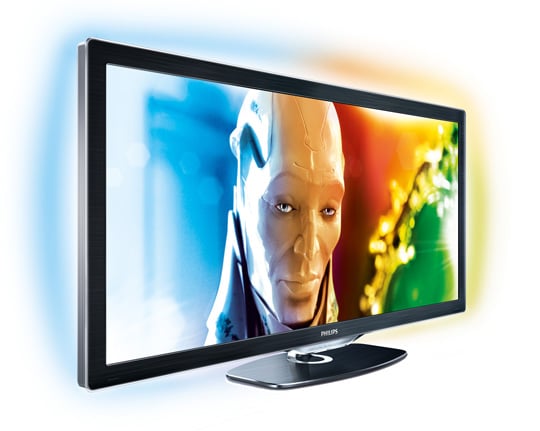
Philips' 21:9 Cinema TV takes the long view:
Let’s get the negatives out of the way first – actually, that won’t take long. It looks weird, frankly, at first. You need to get used to the gargantuan super-wide proportions. Secondly, its greatest strength – near-perfect movie playback – is also a weakness. You won’t always be watching movies and the news looks peculiar when stretched or zoomed to fill the display.
And although this TV truly has cinema screen proportions, lots of DVDs and Blu-rays are formatted to 16:9 ratio, or thereabouts, so the TV has to adjust the onscreen image to fill the TV (which it does very well, by the way).
There’s also the matter of set-up which is notoriously finicky with Philips TVs. Such is the power of the image processing it can easily make content look over-sharp, so filmic subtleties can be lost. Trial and error will set you straight.
Finally, I’d have liked to have seen a Freeview HD tuner in a machine this price, but if you’re this keen on movies you probably have Sky+ HD Or Virgin Media with their many HD film options.
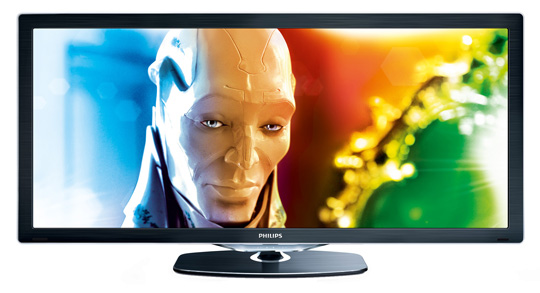
Alas, no Freeview HD tuner on-board
Right, let’s see what’s good. The curved-edge frame with brushed-metal bezel looks pretty classy and the stand is understated but attractive. For its size, the Philips 58PFL9955H isn’t as heavy as you might imagine, though you won’t want to move it around. It utilises the Philips visual menu system, all controlled through the Home button on the remote. Press it and you’ll see a grid of icons including your inputs (PVR, Games console and so on) plus Setup.
Shadow play
Features which make the most of the extra screen real estate include an impressive picture-in-picture capability. The TV has a wireless feature so you can connect to the Philips on-line services through your broadband network and even surf the internet courtesy of the Opera browser. It’s all neatly done, though a web page on a screen this size may overwhelm.
The super-wide TV naturally has a very long top edge, so the Ambilight effect is particularly impressive. Ambilight, as you’ll know, is the Philips speciality where a series of LEDs on the back of the telly play coloured light on the wall behind. The multiple light panels mean the colours thrown on the wall match the image on screen in great detail.
Sample Shots
Ambilight in action
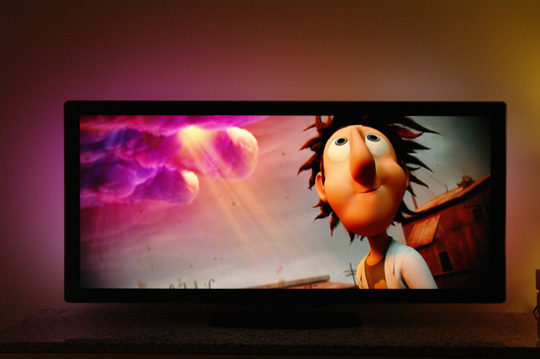
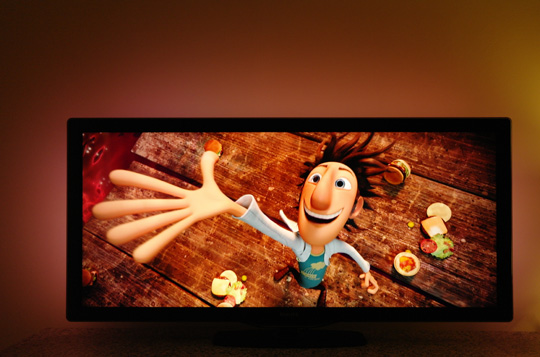
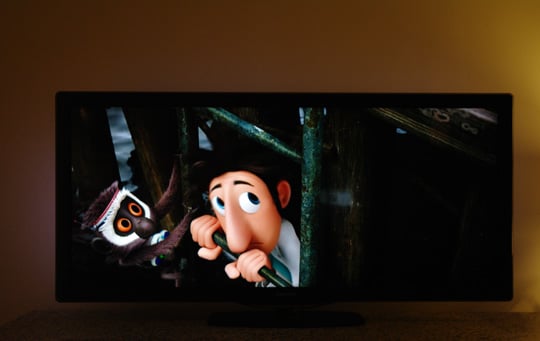
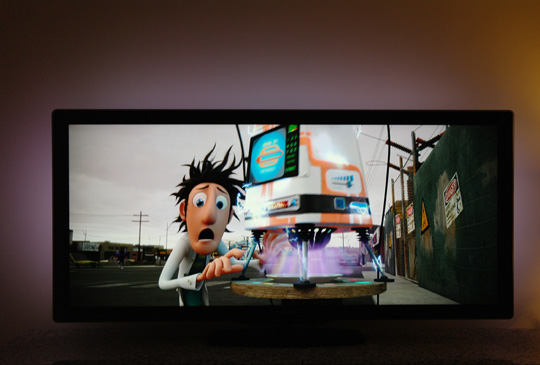
The result is that the image is more restful on the eyes and creates a hugely immersive experience. The TV shrinks when it’s switched off (though obviously in this case that’s still quite big). There’s Ambilight on the two sides and along the top edge. As usual, it’s a wonderful effect and you can even change the base colour to compensate for coloured walls.
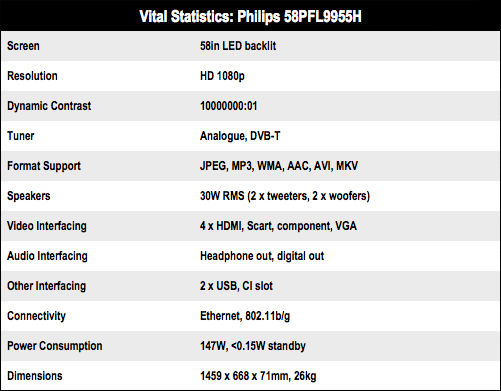
Panel games
Watching 2D movies in high definition is a great experience with this TV. The Philips image processing technology is highly impressive, delivering spectacular detail and rich, natural colours. Unlike last year’s 21:9 debut TV, this one has locally dimmable LED backlighting, which aids the high contrast levels and delivers deep black colours without lessening the screen’s brightness. And the acreage of the 21:9 screen means there are significantly more of those individually dimmable LED clusters than on a conventional screen. When it comes to local dimming, Philips and Samsung know, perhaps better than anyone, how to make it look great.
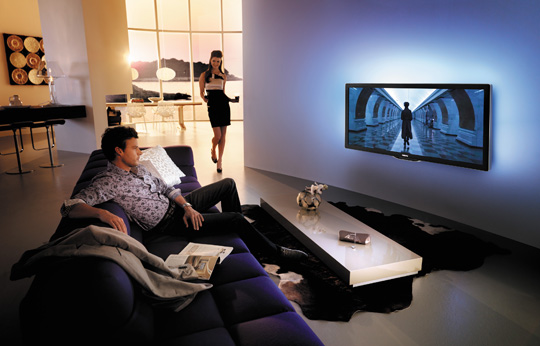
Usherette optional... and cheaper
Standard definition content is pretty good, too, though this tends not to be widescreen at all and you’ll want to zoom in a little to be rid of the suddenly-huge black panels at the sides of the image. Still, the Philips image management engine makes it look as good as it could. As for 3D, it looks just dandy, too. Philips' PTA03 active glasses are used and this TV is a 400Hz screen, so the fast refresh rate reduces smeariness. While it’s true that crosstalk – the unsatisfactory ghosting effect common to 3D LCD screens – isn’t completely gone, it is very low.
To my eyes, this is the best 3D quality on the market: the absence of artefacts or jerkiness makes for a smooth, realistic feel to the jumping-out-of-the-TV effect. There’s a great sense of depth of field and the blurry, nausea-inducing feeling found on some 3D sets is absent here. Sound, as often is the case with Philips, is a cut above the dullness of many flatscreen panels, though if you’re keen enough on film to choose the 21:9, you probably have a home cinema system too. And usherettes, maybe.
Verdict
My, but this TV isn’t cheap. Except, when you factor in all the features, the remarkable aspect ratio and the stand-out picture quality, it sort of is. The picture works well whatever you throw at it but the LED dimming makes widescreen content look really exceptional, aided by the trusty Philips Ambilight effect. The 3D image quality is also stand-out and makes for a highly enjoyable cinema-in-the-living-room experience.
More HD TV Reviews... |
|||
 Group Test Group Test
Freeview HD TVs |
 Sharp Aquos Sharp Aquos
LC-32LE210E |
 Philips Philips
46PFL9705H Ambilight |
 LG LG
50PK990 |